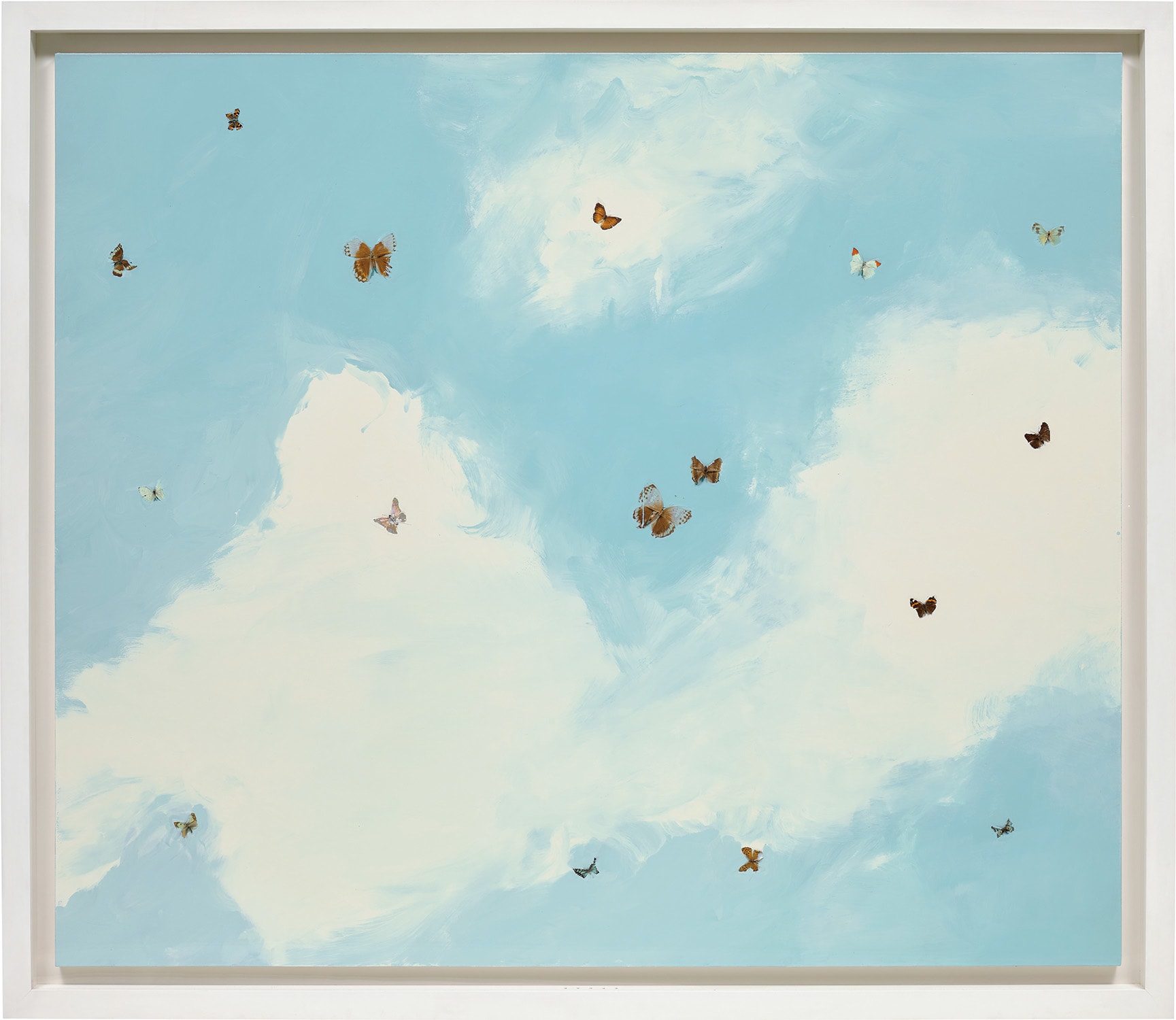

19Ο◆
Damien Hirst
Summer Breeze
Full-Cataloguing
Acquired by Robert Tibbles in the early 2000s, the avid Hirst-collector observed that beyond the multiple links existing between the artist’s plethora of series, a particularly potent one stood out between Hirst’s butterfly paintings and his fly works – and more specifically Summer Breeze, 2002, and AIDS, 2003, which both sat in conversation in Tibbles’ collection for decades. Capturing Hirst’s preoccupation with life and death, Summer Breeze depicts a clear blue sky scattered with butterfly wings glued to the canvas, whereas AIDS engulfs the viewer in darkness, with thousands of flies trapped behind glass. Through almost opposite renditions – one akin to an aesthetic of entrapment and the other deceivingly emulating an image of liberation – these two works convey similar themes, essentially spanning freedom and ensnarement, life and death. About the Butterfly works, Hirst has said: ‘I don’t want it to look like a kind of oil-painted beautiful sky that’s been created. If you use it, thick gloss paint really does, in a very sculptural way, start to form fucking clouds. I want it to look like an accident of gloss paint with butterflies stuck on it’ (Damien Hirst, quoted in Damien Hirst and Gordon Burn, On the Way to Work, London, 2001, p. 133). In this sense, Summer Breeze discreetly addresses the same complex and intense subjects as its visibly darkened counterpart; it is a testimony to the fragility of life, and the often misleading impressions of iridescent beauty.
Yet in its specific use of butterflies – insects that have been gifted a very particular experience of life, at once long in its concoction and quick in its expiration – Summer Breeze also tackles an age-old subject that has fascinated painters, poets, writers, and opera composers across time. By virtue of their beauty, unique growing stages and lifespan, butterflies have enjoyed a repeated presence in the canon of art, scattered in Renaissance paintings and cabinets of wonder, while at the same time maintaining heightened importance in contemporary art. Eminent figures such as Vincent van Gogh, Odilon Redon, Mark Grotjahn, but also Vladimir Nabokov have observed the almost-miraculous status that the winged creatures were bestowed in life. ‘Caressed by the inert and omnivorous body of painting, butterflies, like the animals in formaldehyde, maintain their vital and pulsating aspect’, noted Mario Codognato, ‘even in the stasis of death, prolonging and transferring their final movement in the stasis of representation, and celebrating, simultaneously, their grandeur and their impotence’ (Mario Codognato, ‘Warning Labels’, Damien Hirst: The Agony and the Ecstasy, exh. cat., Museo Archeologico Nazionale, Naples, 2004, p. 41). The universal, timeless and collective fascination surrounding butterflies also lead to more widespread activities, including butterfly-catching and butterfly-collecting. In the common practice of placing butterflies behind glass, man has notably achieved the impression that life can be frozen in the instant of death.
A wondrous, exceptional example of Hirst’s butterfly paintings, Summer Breeze is one of the few formulations of the Butterfly series evincing a non-monochromatic background. The sky backdrop in the present work amplifies the discrepancy that exists between the butterflies’ physical entrapment and their falsely unrestrained flight; as a result, the composition takes on an added poetic layer, whereby living creatures are sunk into an intangible vortex of air – impossibly glued to the summer breeze.
Damien Hirst
British | 1965There is no other contemporary artist as maverick to the art market as Damien Hirst. Foremost among the Young British Artists (YBAs), a group of provocative artists who graduated from Goldsmiths, University of London in the late 1980s, Hirst ascended to stardom by making objects that shocked and appalled, and that possessed conceptual depth in both profound and prankish ways.
Regarded as Britain's most notorious living artist, Hirst has studded human skulls in diamonds and submerged sharks, sheep and other dead animals in custom vitrines of formaldehyde. In tandem with Cheyenne Westphal, former Chairman of Phillips, Hirst controversially staged an entire exhibition directly for auction with 2008's "Beautiful Inside My Head Forever," which collectively totalled £111 million ($198 million).
Hirst remains genre-defying and creates everything from sculpture, prints, works on paper and paintings to installation and objects. Another of his most celebrated series, the 'Pill Cabinets' present rows of intricate pills, cast individually in metal, plaster and resin, in sterilized glass and steel containers; Phillips New York showed the largest of these pieces ever exhibited in the United States, The Void, 2000, in May 2017.